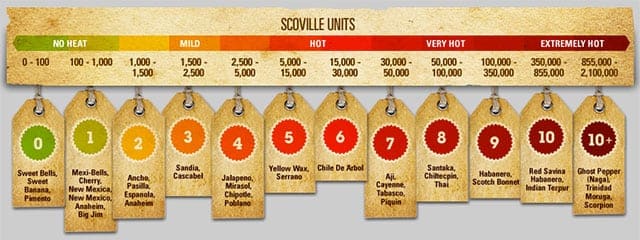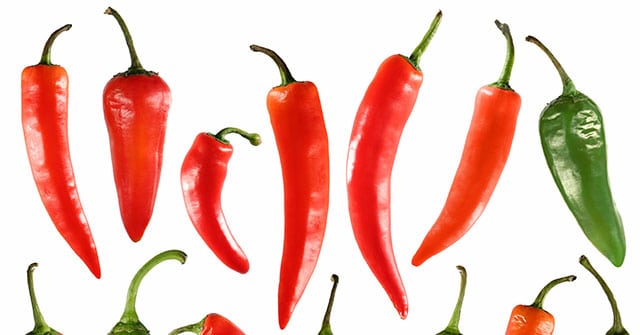Can You Take the Heat?
Do you like to douse your food in hot sauce every chance you get, or eat hot peppers with almost every meal? If so, you’re not alone! Hot peppers have been consumed alone or with food for centuries!
A Brief History of the Hot Pepper
Also known as chile or chili peppers, hot peppers are used all over the world for eating, cooking and flavoring dishes since around 7500 BC. They came about originally in the Americas and grew in popularity all over the world at a surprising speed, and have even been used in medicinal purposes. Spread around the world by humans and animals alike, these are tasty and sometimes spicy additions to nearly any type of meal.
Many think hot peppers are a vegetable, but in fact they are actually the fruit of a nightshade plant called genus Capsicum, which is where the word capsaicin – the ingredient of a hot pepper that gives it a kick – comes from. (Scoville Image via http://badboychilli.co.uk)

How Is the Heat Of A Hot Pepper Gauged?
The capsaicin in hot peppers activates the areas of your mouth and even your throat that react to hot, burning sensations. When this happens, your brain reacts as well, which is why you feel pain, feel your heart pick up speed and even begin to sweat. There are so many different types of hot peppers that it is difficult to keep track of what every single one tastes like, and which is hotter than the others. Thankfully, Wilbur Scoville came up with a handy system to measure the intensity of hot peppers called The Scoville Scale.
Using the Scoville Scale helps determine just how hot a hot pepper is before you eat it. The scale isn’t exact, meaning the way your mouth and body reacts to a hot pepper may be more or less intense than those who created the scale, which is why the measurements – called SHU, which stands for Scoville Heat Units – are shown in ranges.

A Few Different Types of Common Hot Peppers and Their Intensity
Bell
Crunchy and mild with a sweet taste, these peppers have no heat at all as it doesn’t contain any capsaicin, and place at a 0 on the Scoville Scale. They are commonly used for cooking to enhance the flavor of food, bell peppers come in multiple colors and flavors, the most common being red, green, yellow and orange. Depending on the color, these peppers can range in taste as well, with some being tangy and others having a more bitter flavor.
Poblano
Originating from Mexico this pepper can range between 1,000 and 2,000 SHU on the Scoville Scale, and are a deep green when ripening (although later in their life span they turn red). Many are mild but sometimes they can have an unexpected kick to them as peppers from the exact same plant can vary greatly in heat, meaning you won’t be able to tell how hot a poblano pepper is until you bite into it.
Jalapeño
Picked when green but red when fully ripe, this hot pepper can pack a punch. The flesh itself is mild, crunchy and almost sweet, but it is the seeds that hold this pepper’s heat. If seeded properly (don’t forget to use gloves!) these can be a great addition to many dishes without having too much spice. However, leave the seeds in for a nice, slow burn, as the jalapeño pepper’s Scoville Heat Rating starts at 1,000, but can reach up to 4,000 SHU.
Chipotle
Now we are getting quite spicy! Another common hot pepper is called the chipotle pepper. Ranging from 3,500 to as high as 10,000 SHU, this is actually a jalapeño that has been smoke-dried, giving these hot peppers a smoky flavor.
Cayenne
Ranging from 30,000 to 50,000 SHU, these are some pretty hot peppers. They are most commonly used in cooking after being ground up into a powder, and can add a ton of heat even when using a small amount. It is one of the different types of peppers you see used when you put crushed red pepper flakes on your pizza or pasta. Some people even use the cayenne pepper as an herbal supplement for stomach issues, headaches, sinus infections as well as health problems of the heart and/or blood.
Habanero
These tiny, colorful fruits really have a ton of heat. It has an almost fruity flavor and a very powerful burn, which earned it the title of “World’s Hottest Chili Pepper” back in the 90s due to its Scoville rating of 100,000 to 350,000 SHU. However, new hot peppers are found frequently, so it no longer holds that title, but people still use it to this day to add an intense heat to their dishes.
Ghost
At 855,000 to 1,000,000 SHU, the ghost pepper – its proper name is the bhut jolokia pepper – is currently considered one of the top ten hottest peppers in the world. These hot peppers can be orange, red, yellow or even brown, and many cannot eat them due to their extreme heat. In fact, many people in other countries smash these peppers along their fences or on their doors and windows to keep away wild animals, and still others use the powder form in smoke bombs to flush out terrorists or prisoners during a riot. In food, however, this hot pepper can be used to bring out amazing flavor in any dish.

Consuming Hot Peppers – Is It Good For You?
Many people think that eating hot chilies or using hot sauce can ruin your stomach or intestinal tract, but it has been proven that there are many different health benefits of hot peppers.
Health benefits of hot peppers
- Hotter peppers are used as a nasal decongestant, especially useful for allergies or sinus infections
- Bell peppers have a lot of Vitamin C
- Heat from spicy peppers can actually help with cluster headaches and joint pain
- Studies have shown that those who eat more spicy foods have lower risks of heart issues
- Hot peppers help increase circulation
- Stomach issues such as gas and digestion problems have been cured with hot spices
However, there are a few downsides to eating too many hot peppers.
- Spicy food can cause heartburn
- Can cause inflammation on the walls of your internal organs if eating too much at once, leading to gastritis
- Spicy foods can also cause bad breath
- Your body might have a bad reaction to the pain, causing increased heart rate, sweating and nausea
If you find yourself unable to take the heat, make sure you have a few glasses of milk to cut the burn down. There are definitely more health benefits than issues caused by eating hot peppers. Like most things, make sure you just use hot foods in moderation, and only eat what your body can handle. If you feel you have burned your mouth, or if you have questions or experiences with hot peppers, be sure to share at your next scheduled cleaning and check up.


